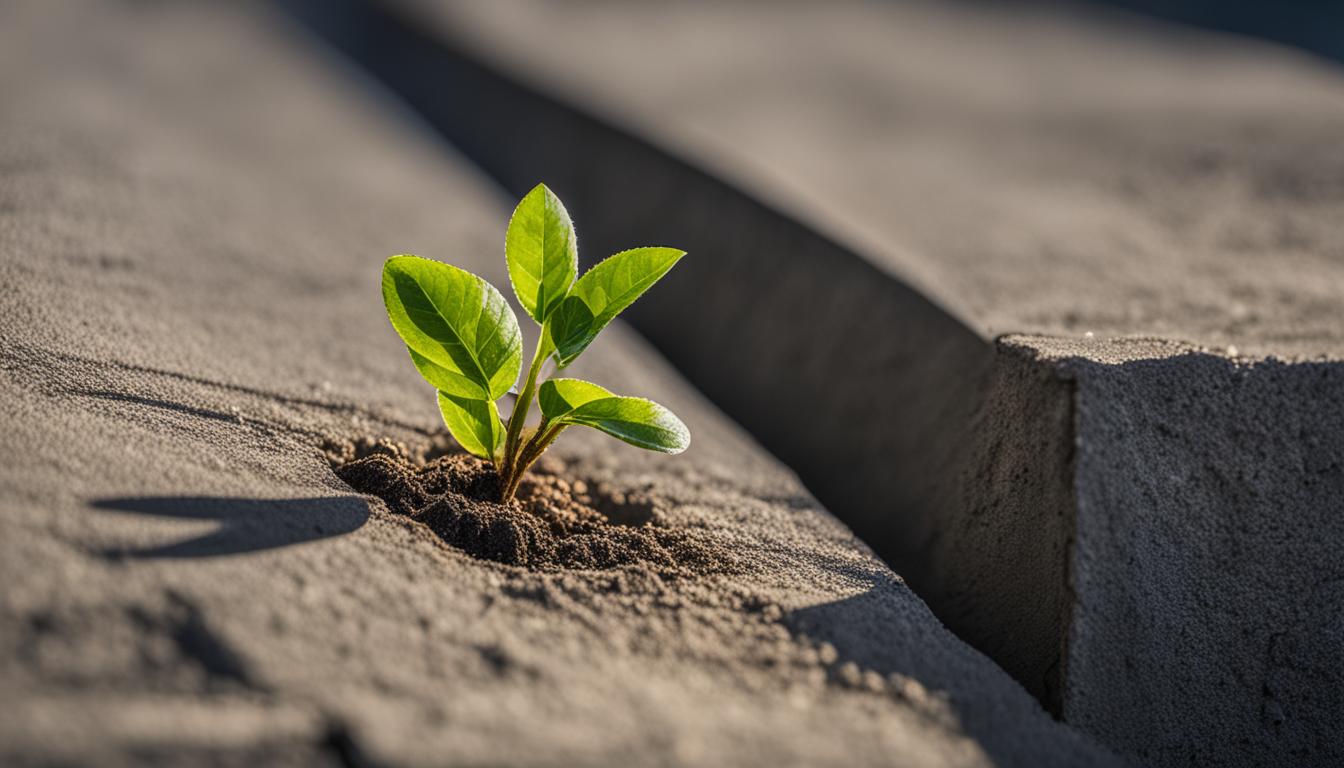Change is a constant in life, and navigating life transitions can be transformative. Embracing change starts with cultivating a growth mindset and finding comfort in discomfort. Setting clear intentions, embracing flexibility and adaptability, seeking support and connection, practicing self-compassion, and embracing the journey can all help in navigating through life’s transitions.
Key Takeaways:
- Embrace change as an opportunity for personal growth
- Cultivate a growth mindset to adapt and evolve during transitions
- Find comfort in discomfort and uncertainty to discover new capabilities
- Set clear intentions and goals to navigate transitions with purpose
- Embrace flexibility and adaptability to make the most out of any situation
The Nature of Change and Transition
Change is a natural part of life, bringing both excitement and uncertainty. Life transitions encompass various shifts, such as career changes, moving to a new city, or personal transformations. Understanding the nature of change and transition is crucial for successfully navigating through these periods of transformation.
Life transitions are not isolated events; they are continuous processes that shape our lives. As we embrace change, we open ourselves up to new opportunities for growth and personal development. It is through these transitions that we discover our resilience, adaptability, and inner strength.
Life transitions can be viewed as chapters in our personal journey. Each transition offers us the chance to redefine ourselves, explore new paths, and expand our horizons. By embracing the inherent nature of change, we can adapt to the ever-evolving world around us and navigate through life transitions with grace and confidence.
Cultivating a Growth Mindset
Embracing change starts with adopting a growth mindset. A growth mindset is the belief that our abilities and intelligence can be developed through dedication and effort. It involves seeing every new experience as a chance to learn and grow, rather than viewing challenges as obstacles or failures. With a growth mindset, we can approach change with curiosity, resilience, and a willingness to try new things.
“The only limit to our realization of tomorrow will be our doubts of today.” – Franklin D. Roosevelt
To cultivate a growth mindset, it’s important to challenge our fixed beliefs and embrace the idea that we can always improve. Rather than fearing change, we can see it as an opportunity for personal development. By seeking out new challenges, acquiring new skills, and embracing lifelong learning, we can continuously evolve and adapt to the changing world around us.
Embracing change with a growth mindset not only helps us navigate life’s transitions but also fosters personal growth and fulfillment. It allows us to break free from self-imposed limitations and embrace our full potential. So let’s cultivate a growth mindset and embrace change as a catalyst for personal development and a pathway to a more meaningful and fulfilling life.

The Power of a Growth Mindset
A growth mindset empowers us to:
- Embrace challenges and view them as opportunities for growth
- Persist in the face of setbacks and learn from failures
- Seek out feedback and use it constructively
- Be inspired by the success of others and learn from their achievements
- Believe in our ability to improve and achieve our goals
A growth mindset opens doors to new possibilities and allows us to embrace change with confidence and optimism. By cultivating this mindset, we can unleash our full potential and create a life of continuous growth and personal development.
Embracing Discomfort and Uncertainty
Change often takes us out of our comfort zones and into the unknown. It can be unsettling and challenging, but embracing discomfort and uncertainty is a crucial step towards personal growth. By stepping outside of our comfort zones, we open ourselves up to new experiences and opportunities for self-discovery. It is in these moments of discomfort that we truly find our strength and resilience.
Embracing discomfort and uncertainty requires a shift in perspective. Instead of fearing the unknown, we can learn to see it as an adventure, full of possibilities. As Albert Einstein once said, “Life is like riding a bicycle. To keep your balance, you must keep moving.” When we allow ourselves to embrace the discomfort and uncertainty of change, we are actively moving forward and evolving as individuals.
It is important to remember that personal growth does not happen within our comfort zones. It is when we push ourselves beyond what is familiar and safe that we begin to unlock our true potential. Embracing discomfort and uncertainty allows us to tap into our inner resilience and adaptability. It nurtures our ability to navigate life’s challenges and setbacks with grace and determination. So, let us embrace the discomfort and uncertainty that comes with change, knowing that it is through these experiences that we grow and become the best versions of ourselves.
Setting Clear Intentions
When embarking on any major life transition, setting clear intentions is crucial. It provides a roadmap for navigating the change and helps us stay focused on our goals and aspirations. By taking the time to define what we hope to achieve through the transition, we can better align our actions and make choices that support our desired outcome.
Setting intentions involves reflecting on what truly matters to us and what we want to experience or accomplish during this period of change. It’s about identifying our values, passions, and priorities, and using them as a compass to guide our decisions. By setting clear intentions, we create a sense of purpose and direction, giving us the motivation and determination to overcome any obstacles that may arise.
Goal setting is an integral part of setting clear intentions. By breaking down our larger aspirations into smaller, actionable steps, we can make progress towards our goals and stay motivated along the way. Whether it’s creating a detailed plan or simply writing down our objectives, setting goals allows us to measure our progress and celebrate our achievements as we navigate through life’s transitions.

Key Points:
- Setting clear intentions provides a roadmap for navigating life transitions.
- It involves defining what we hope to achieve and aligning our actions with our desired outcomes.
- Goal setting helps break down larger aspirations into smaller, actionable steps.
- By setting clear intentions and goals, we stay focused and motivated as we navigate through change.
By setting clear intentions and goals, we empower ourselves to embrace change and make the most of life’s transitions. It allows us to approach the journey with purpose and determination, ensuring that we are actively shaping our future. So, whether you’re starting a new career, moving to a different city, or embarking on a personal transformation, remember the power of setting clear intentions and the impact it can have on your journey.
Embracing Flexibility and Adaptability
Change is inevitable, and navigating through life transitions requires us to be flexible and adaptable. Embracing change means being open to new possibilities and adjusting our plans when necessary. As the famous quote by Charles Darwin goes, “It is not the strongest of the species that survives, nor the most intelligent; it is the one most adaptable to change.”
In a world that is constantly evolving, embracing flexibility allows us to thrive in uncertain situations. By being flexible, we can quickly pivot and find creative solutions to challenges that come our way. It enables us to let go of rigid expectations and embrace the unexpected opportunities that change brings.
Adaptability goes hand in hand with flexibility. It means having the willingness to learn new skills, acquire new knowledge, and adjust to different circumstances. Embracing adaptability enables us to stay relevant and navigate through life transitions with resilience. As technology continues to advance and industries shift, being adaptable allows us to seize new opportunities and stay ahead of the curve.
Embracing Change: Key Points
- Be open to new possibilities and adjust plans when necessary
- Embrace flexibility to find creative solutions and thrive in uncertain situations
- Cultivate adaptability to learn new skills and stay relevant in a changing world
Embracing flexibility and adaptability is essential when navigating life transitions. By being open to change, we can embrace new opportunities, learn and grow, and ultimately find personal fulfillment along the journey.

Seeking Support and Connection
During times of change and transition, having a strong support network can make all the difference. Surrounding ourselves with trusted friends, family, or mentors can provide valuable insights, guidance, and a sense of belonging. By seeking support and connection, we can navigate through life’s transitions with greater ease and confidence.
Sharing our experiences, fears, and aspirations with others allows us to gain different perspectives and learn from their wisdom. It reminds us that we are not alone in our journey and that others have likely faced similar challenges. This sense of camaraderie can be empowering and reassuring as we navigate the unknown.
The Power of Connection
Connecting with others who are navigating similar transitions can be particularly beneficial. Joining support groups, attending workshops or seminars, or participating in online communities can provide a space for shared experiences and mutual support. These connections can not only offer emotional support but also valuable resources, tips, and strategies for navigating transitions effectively.
“Connection is the energy that is created between people when they feel seen, heard, and valued.” – Brené Brown
By reaching out and seeking guidance, we give ourselves permission to lean on others and share the weight of our challenges. This vulnerability can foster deep connections and create a sense of belonging that fuels our personal growth and resilience. Together, we can navigate transitions with strength and grace.
The Power of Self-Compassion in Navigating Change and Fostering Personal Growth
Change can be a challenging and uncertain journey, but practicing self-compassion can be a powerful tool to navigate through it. When we embrace change with kindness and understanding towards ourselves, we create a supportive internal environment that nurtures personal growth.
Self-compassion involves acknowledging and validating our feelings during times of change, understanding that it’s okay to feel overwhelmed or uncertain. It allows us to extend the same empathy and compassion we would offer a loved one to ourselves. By treating ourselves with kindness, we cultivate resilience and develop a healthy mindset to face the challenges that come with navigating change.
“Self-compassion is not self-indulgence; it is self-preservation.”
Quotes like this remind us of the importance of self-compassion as an essential aspect of our well-being. It is not selfish to prioritize self-care during times of change. In fact, it is necessary for our emotional and mental health. By practicing self-compassion, we can reduce stress, enhance our self-esteem, and foster personal growth.
When we embrace change with self-compassion, we create a nurturing environment for ourselves. It allows us to be patient with our progress, celebrate our achievements, and forgive ourselves for any missteps along the way. Self-compassion helps us build resilience, enabling us to bounce back from setbacks and move forward with a renewed sense of purpose and personal growth.
Practicing Self-Compassion:
- Pause and acknowledge your feelings with kindness and understanding.
- Treat yourself with the same empathy and compassion you would offer a loved one.
- Practice self-care to prioritize your well-being during times of change.
- Celebrate your progress and achievements, no matter how small they may seem.
- Forgive yourself for any mistakes or setbacks, understanding that they are opportunities for growth.

By practicing self-compassion, we not only navigate change with kindness but also create the conditions for personal growth to flourish. It is through self-compassion that we can embrace the journey, find joy in change, and emerge stronger and wiser on the other side.
Embracing the Journey: Finding Joy in Change and Personal Growth
When navigating life transitions, it’s important to not just focus on the end destination, but also to embrace and appreciate the journey itself. Change can be both exciting and daunting, but by finding joy in the process, we can experience personal growth and transformation.
Embracing the journey means being present in each moment, fully immersing ourselves in the new experiences and opportunities that arise. It’s about taking the time to appreciate the small victories along the way and savoring the lessons we learn from both successes and setbacks. As we embrace the journey, we develop a mindset that allows us to see change not just as a means to an end, but as a continuous source of growth and fulfillment.
“The real voyage of discovery consists not in seeking new landscapes, but in having new eyes.” – Marcel Proust
These words from Marcel Proust remind us that change is not just about external transformations, but also about the internal shifts in our perception and understanding. By embracing the journey, we open ourselves up to new perspectives and possibilities, allowing personal growth to unfold naturally.
So, as you navigate life transitions and embrace change, remember to find joy in the journey. Take the time to appreciate each step along the way and celebrate your progress. By embracing the journey, you’ll not only experience personal growth, but also cultivate a sense of fulfillment and gratitude for the transformative power of change.
Building Resilience

Building resilience is crucial when navigating through life transitions. It is the ability to bounce back from setbacks, adapt to change, and continue growing personally. Resilience allows us to face challenges head-on, learn from our experiences, and emerge stronger than before.
One way to build resilience is by nurturing mental fortitude. This involves developing a positive mindset and believing in our own abilities. By focusing on our strengths and practicing self-affirmation, we can cultivate a resilient mindset that helps us overcome obstacles and persevere.
Another important aspect of building resilience is fostering a support network. Surrounding ourselves with people who uplift and inspire us can provide encouragement and guidance during times of setback. Connecting with others who have navigated similar transitions can offer valuable insights and a sense of camaraderie.
The key to resilience is self-care
Practicing self-care is crucial in building resilience. Taking time for ourselves, engaging in activities that bring us joy, and prioritizing our physical and mental well-being all contribute to our ability to navigate setbacks. By replenishing ourselves, we can better cope with challenges and maintain a positive attitude.
Embracing a growth mindset
Embracing a growth mindset is an essential component of resilience. This mindset allows us to see setbacks as opportunities for growth and learning. By reframing setbacks as stepping stones and viewing them as temporary, we can bounce back stronger and more determined than before. A growth mindset encourages us to believe in our ability to adapt, learn, and thrive in the face of adversity.
Resilience is not about avoiding challenges, but about navigating them with strength and determination.
By building resilience, we can navigate setbacks with grace and perseverance. It is through these challenges that we grow, learn, and discover our true potential. Building resilience is a lifelong journey, and with each transition we navigate, we become stronger and more resilient individuals.
Conclusion
Embracing change is crucial for personal growth and navigating life transitions. By cultivating a growth mindset, embracing discomfort, setting clear intentions, seeking support, practicing self-compassion, embracing the journey, and building resilience, we can confidently navigate change and find fulfillment in the process.
Change is an opportunity for growth and transformation. It allows us to evolve, learn, and discover our true potential. By embracing change, we open ourselves up to new possibilities and experiences that can shape us into the best versions of ourselves.
Navigating life transitions can be challenging, but with the right mindset and support, we can overcome any obstacles that come our way. As we embark on our personal journeys, let us remember to be kind to ourselves, celebrate our progress, and stay present in each moment. Through embracing change, we can create a life filled with personal growth, fulfillment, and happiness.
FAQ
What are life transitions?
Life transitions refer to significant changes or transformations that occur in various areas of life, such as career shifts, relocation, or personal growth.
How can I embrace change?
Embracing change starts with cultivating a growth mindset, finding comfort in discomfort, setting clear intentions, embracing flexibility and adaptability, seeking support and connection, practicing self-compassion, and embracing the journey.
How can a growth mindset help me navigate life transitions?
A growth mindset involves seeing every new experience as an opportunity to learn and grow. It allows you to adapt, evolve, and view life transitions as chances for personal development.
Why is embracing discomfort and uncertainty important during life transitions?
Embracing discomfort and uncertainty can lead to personal growth and new discoveries. Stepping out of your comfort zone can help you unlock your true capabilities and embrace new possibilities.
What is the importance of setting clear intentions during life transitions?
Setting clear intentions involves defining what you hope to achieve through the change and establishing your goals and aspirations. Clear intentions provide a roadmap and a sense of purpose during the transition.
How can flexibility and adaptability help me navigate life transitions?
Life doesn’t always go as planned, and change can bring unexpected surprises. Embracing flexibility and adaptability allows you to go with the flow, adjust your approach, and make the most out of any situation.
Why is seeking support and connection important during life transitions?
During times of change, leaning on your support network can provide valuable insights, guidance, and a sense of belonging. Sharing experiences, fears, and aspirations with trusted individuals can help you navigate transitions more effectively.
How can practicing self-compassion benefit me during life transitions?
Change can be challenging, so it’s essential to be kind to yourself throughout the process. Practicing self-compassion involves acknowledging your feelings, celebrating your progress, and forgiving yourself for any missteps. It allows you to navigate change with kindness and understanding.
Why is embracing the journey important during life transitions?
While goals are important, appreciating the journey itself is equally vital. Embracing change means being present in each moment, finding joy in small victories, and savoring the lessons along the way. It helps you find fulfillment and personal growth throughout the transition.
How can I build resilience when navigating life transitions?
Building resilience involves nurturing mental fortitude, fostering a support network, practicing self-care, and embracing a growth mindset. It’s about bouncing back from challenges and using setbacks as opportunities for learning and self-improvement.
How can embracing change lead to personal growth?
By cultivating a growth mindset, embracing discomfort, setting clear intentions, seeking support, practicing self-compassion, embracing the journey, and building resilience, you can navigate change with confidence and find personal growth and fulfillment along the way.


